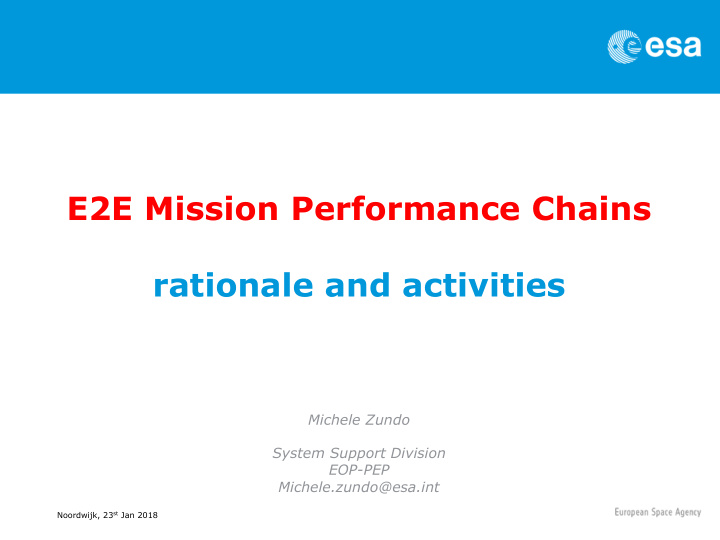



E2E Mission Performance Chains rationale and activities Michele Zundo System Support Division EOP-PEP Michele.zundo@esa.int Noordwijk, 23 st Jan 2018
Content 1. Challenges and concepts 2. Who are Actors/Users 3. Tasks in the domain of Mission performance 4. What is a Mission performance (tool) Chain . 5. Mission Lifecycle A à E and Mission performance 6. Existing documentation, tools and framework Noordwijk, 23 st Jan 2018
Mission Performance Chains Noordwijk, 23 st Jan 2018
What is Mission performance ?? Satellite Payload design design Operation Concept L1 Algorithm Mission Performance L2 Algorithm Noordwijk, 23 st Jan 2018
Actors and Competences EOP-P Project Sat/Inst. L1PP Industry Industry Instrument Engineer Mission Scientist TEC support Processor L2PP Engineer Industry GS Engineer Operational Study GS Manager Noordwijk, 23 st Jan 2018
Common E2E Chain Tasks (examples) Instrument and Platform Support industry Calibration algorithm Monitoring algorithm design /implementation and implementation requirements prototyping of instrument/platform prototyping verification Operational concept (Phase 0/A) Processing of confirmation and L1PP algorithm refinement definition on-ground Study and what-if analysis and prototyping characterisation Mission Selection (e.g. calibration freq.) Shadow Space Segment Industry work Sensitivity analysis Independent E2E assessment at ESA Independent (error/effects on L1) Verification Industry L2 algorithm and Sensitivity analysis Project target simulation Test Data Generation (errors/effects on definition and Scientist L2/L3) prototyping Ground Segment Noordwijk, 23 st Jan 2018
Algorithms vs Engineering of Mission Performance Chain 1.Algorithm/requirements are specific, e.g: “ My mission is special ” Active MW Active algo Instrument Optical Instrument Level 1 Passive Calibration Level 2 Optical Retrieval Instrument 2.Engineering, architecture, tools are common! Target Instrument Level 1 Level 2 Assessment Geometry generation Simulation processing processing Tools Noordwijk, 23 st Jan 2018
Mission Performance and Lifecycle Architecture Simplified Mission Observing System Phase Feasibility Cost Mission Level perf. Candidate Simulator study estimation Estimates Selection architecture 0/A/B1 (L2) Evolution not redesign Complete Detailed Confirm Detailed Definition of Phase payload/ Design and L1PP/L2PP Products and Instrument as-built B2/C/D platform definition Calibration Simulator Performance modelling and GPPs Noordwijk, 23 st Jan 2018
What is available today for Mission Performance Chains Architecture definition (ARCHEO) Docs Template doc for Standard Interface Definition Simulators and GPP Building SW/architecture requirement Block definition (BIBLOS) (Generic E2E ICD) (annex to SAT-SRD) Common function libraries e.g. Orbit, Attitude, CCSDS Open Source SW components Orchestration framework SW read/write for Algorithm (BIBLOS) (openSF) (DFDL4S, EOCFI) http://eop-cfi.esa.int/ Noordwijk, 23 st Jan 2018
Reference Architecture (ARCHEO) Noordwijk, 23 st Jan 2018
BIBLOS component library https://gmv-biblos.gmv.com/ Noordwijk, 23 st Jan 2018
Take away message 1. Every mission needs to assess its performance 2. Different use cases, actors and type of work however same framework can be used which will eventually save time and money. 3. Work in Phase 0/A/B should be seamlessly reused in C/D 4. Experience and best practice exists 5. Open licence SW tools, algo, documentation exists already Noordwijk, 23 st Jan 2018
Recommend
More recommend